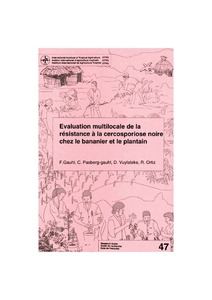| dc.contributor.author | Defloor, I. |
| dc.contributor.author | Leijskens, R. |
| dc.contributor.author | Bokanga, M. |
| dc.contributor.author | Delcour, J. |
| dc.date.accessioned | 2019-12-04T11:26:21Z |
| dc.date.available | 2019-12-04T11:26:21Z |
| dc.date.issued | 1994 |
| dc.identifier.citation | Defloor, I., Leijskens, R., Bokanga, M. & Delcour, J. (1994). Impact of genotype and crop age on the breadmaking and physico-chemical properties of flour produced from cassava (Manihot esculenta Crantz) planted in the dry season. Journal of the Science of Food and Agriculture, 66(2), 93-202. |
| dc.identifier.issn | 0022-5142 |
| dc.identifier.uri | https://hdl.handle.net/20.500.12478/4553 |
| dc.description.abstract | The bread making potential of cassava flour (in cassava flour/defatted soya flour/glyceryl monostearate recipes (80:20:3, w/w)) prepared from 10 IITA cassava genotypes harvested at the International Institute of Tropical Agriculture (IITA) at 6, 9, 12, 15 and 18 months after planting, was investigated. Bread quality in general was much more dependent on the age of the cassava at harvest time than on the effects of genotype. Thus, the quality of the bread (judged by the regularity of the crumb) produced from flour from crops harvested 12 months after planting was the best in general, with that from flour resulting from 9-month plants superior to that resulting from 6-month plants. Harvesting at 15 or 18 months led to a reduction in bread quality although the effects varied for different genotypes. Brabender peak viscosity varied widely within each set of flour samples harvested at any particular harvest time, but also with the harvest time itself. By differential scanning calorimetry (DSC) (moisture: dry matter ratio 2.1 w/w), the 6-month samples were characterised by two endothermic transition peaks, one at ca 72°C and one at ca 78°C. With increasing age at harvest time (up to 15 months), the 72°C peak became relatively more important, resulting in a 'disappearance' of the 78°C peak in the thermogram. The 18-month samples again showed a 78°C gelatinisation peak or at least a shoulder thereof. The peak multiplicity of the 6-month samples also occurred in DSC experiments with moisture: dry matter ratio of 6.0 (w/w), showing that such samples have a unique gelatinisation pattern. Differences in the analytical values (a-amylase activity, and starch, fibre and protein content) could not explain the differences in bread making potential. |
| dc.language.iso | en |
| dc.subject | Cassava |
| dc.subject | Flours |
| dc.subject | Breadmaking |
| dc.title | Impact of genotype and crop age on the breadmaking and physicochemical properties of flour produced from cassava (Manihot esculenta Crantz) planted in the dry season |
| dc.type | Journal Article |
| dc.description.version | Peer Review |
| cg.contributor.affiliation | Katholieke Universiteit, Leuven |
| cg.contributor.affiliation | International Institute of Tropical Agriculture |
| cg.coverage.region | Acp |
| cg.coverage.region | Africa |
| cg.coverage.region | Europe |
| cg.coverage.region | West Africa |
| cg.coverage.country | Belgium |
| cg.coverage.country | Nigeria |
| cg.isijournal | ISI Journal |
| cg.authorship.types | CGIAR and advanced research institute |
| cg.iitasubject | Food Security |
| cg.iitasubject | Livelihoods |
| cg.iitasubject | Cassava |
| cg.iitasubject | Value Chains |
| cg.accessibilitystatus | Limited Access |
| local.dspaceid | 100803 |

